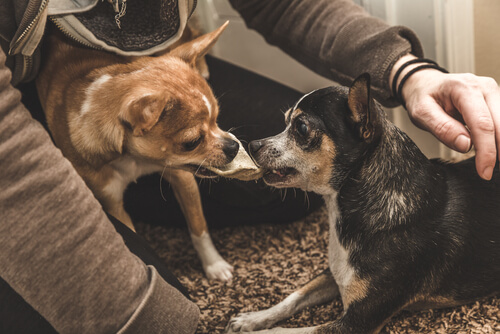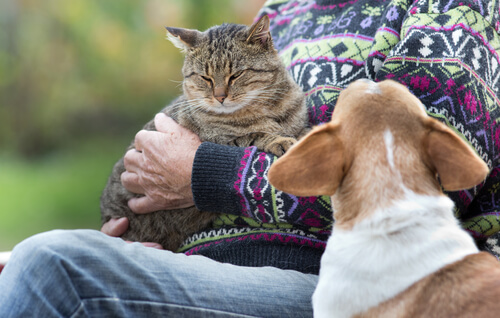How to Prevent and Treat Jealousy Among Pets

Animals are beings that feel and experience emotions, just like people, so it is normal to have jealousy among pets: either between them, when someone visits the house or when a baby arrives. Today we will give you some tips on how to prevent and treat these types of situations.
Causes for Jealousy Among Pets
Whether an animal will be jealous or not can not be determined until an event that demonstrates as much occurs. Generally speaking, pets are accustomed to the presence of other beings, but sometimes they can not repress their jealousy towards them.
Did you know, for example, that small dog breeds tend to be territorial and possessive with their owners and objects? They consider any ‘intruder’ as a threat. On the other hand, large dog breeds tend to be more sociable and companionable.
Of course, that does not mean that being a Golden Retriever or a Boxer is sufficient reason for the animal not to feel jealousy: the education they have or have not received also has a major influence over their attitudes. If the dog has been raised as the baby of the house and suddenly a ‘real’ child appears, the dog is likely to feel displaced or abandoned.

The same can occur if the family adopts a new pet: the newcomer becomes the culprit of the other animals’ lack of attention or care. In these cases, additional competition arises to see who the favorite is, or to determine who “deserves” the most love and affection.
Tips on Avoiding Jealousy Among Pets
Animals may not have the ability to speak, but they can make themselves understood, so if your pet is jealous you will notice certain changes in their attitude. He or she will experience irritability, apathy, anxiety, sadness and possessive attitudes.
It is also likely that your pet will destroy its toys or bed, urinate in forbidden places and have a desire to attack the alleged threat. Here are a few tips that can help you and your dog so he or she does not feel jealous of another animal living in your home:
1. Spend Time with Him or Her
If you have recently had a baby, it definitely becomes more difficult to dedicate time to your pet (or anything other than your new-born child.) However, it’s important that you take a few minutes to play with your pet, or at least to spoil him or her for a while.
For example, before going to bed, lie on the sofa and let your pet sit on your lap or at your feet. It would be even better if you could throw a ball or a wooden stick for them to play with, but the most important thing is for your pet to know that you care about him or her.
2. Introduce the New Family Member (or Members)
It is very important to properly introduce everyone when a new pet or a baby comes home. Let them get to know each other and spend time together.
If jealousy becomes an issue because you have adopted a dog or cat, do everything you can at first to make sure they each have designated spaces and belongings: two beds, two food bowls, two similar toys, two leashes, etc. There will come a time for them to share their things, but at first, it is best to separate them to avoid problems.
3. Enforce your Authority
Do not feel guilty about your pet’s jealousy: it is a normal part of their development and it has a solution. If you are not paying enough attention to your dog, he or she will perceive this weakness and ask you for more care and attention.

You should never allow your pet to ‘do whatever it wants’ because he or she is sad. To the contrary, your pet must continue to follow your orders as he or she always has. This is how your pet will realize that you are still the boss.
4. Avoid Direct Competition
If your dog is very terriorial, it is not a good idea to bring another animal into your home (unless they are the same gender) because this will only provoke jealousy between them. You can however sterilize them both, and thus reduce any related inconveniences.
Lastly, be sure not to treat your pets even the slightest bit differently, because believe it or not, they notice everything. Both of them are equal in your eyes and that should be palpable: if you give one dog a toy, you must also give one to the other; if you take one out on a walk, the other should either accompany you or also be taken on a separate walk; if you play with one, the other can participate, etc.
This text is provided for informational purposes only and does not replace consultation with a professional. If in doubt, consult your specialist.